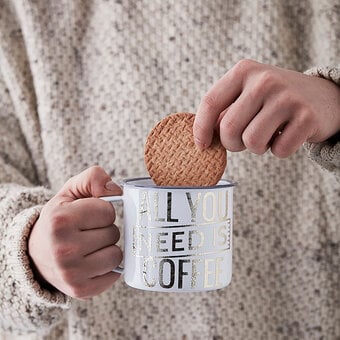Glowforge: How to Make Personalised Keyrings
Are you ready to get crafting with your Glowforge machine? Discover three superb keyring ideas that can be personalised to suit your style.
Whether you're adding a name, initial or photo to your keyring, create a truly unique handmade decoration that you'll love to show off!
You will need
How to make
* Glowforge Proofgrade Medium Natural Leather
* Keyrings
* Embroidery Threads
* A Needle
* Scissors
* Free Templates – Downloaded + Printed
* A Glowforge Printer

Download the templates below in preparation for each keyring project.
Alphabet Keyring:
Download the PDF template here
Name Keyring:
Download the PDF template here
Photo Keyring:

To begin, download the free alphabet keyring file.
Place the leather in your Glowforge and open the Glowforge homepage on your device.

Click on 'create a new design' on the left of the screen, and then click on 'upload a file' and upload the alphabet keyring file. Make sure to delete the letters you don’t want to use.
The software will detect the Glowforge proofgrade material and load the settings for cut and engrave automatically.

Click 'print' and press the flashing button on your Glowforge.
Once the print is finished, remove the leather from the machine.


Cut a length of embroidery thread and split it in half so you have two lengths of three-strand thread.
Top Tip: This is a great way to use up left over bits of embroidery thread you’ve saved!
Fold the tab at the top of the letter over so that both sets of holes line up. Put a cross stitch in to secure the pieces of leather together, leaving a long bit of thread at the beginning and the end. This will allow you to double knot them together to secure the thread.
Trim the ends.






When you’re happy with the placement, delete the line as it is for positioning only.
The software will detect the Glowforge proofgrade material and load the settings for cut and engrave automatically.

Click 'print' and press the flashing button on your Glowforge.
When the print is finished, remove the leather from the machine.

Remove the mask from the leather.
Cut a length of embroidery thread and split it in half so you have two lengths of three-strand thread.
Top Tip: This is a great way to use up left over bits of embroidery thread you’ve saved!

Fold the end to the left of the name so that the holes match up (right sides facing out), and sandwich the other end between them.
Make sure the holes on all three pieces of leather line up.

Put a cross stitch in to secure the pieces of leather together, leaving a long bit of thread at the beginning, and the end so that you can double knot them together to secure the thread.
Trim the ends.


To begin, download the free photo keyring file.
Place the leather in your Glowforge and open the Glowforge homepage on your device.


Click the type icon (the T at the top of the screen underneath community), and type in one of your initials. Set the typeface to Berkshire Swash and text size to 30pt.
Do the same for the ampersand and the other initial, making the ampersand 48pt in size.

Select the letters and the ampersand, click on the align tool (in the bottom left corner above the ruler icon) and click 'middles' to align them horizontally.
You can move the letters and ampersand closer together or further apart until you’re happy with how they look. Then group them.

Move the initials onto the keyring artwork, and use the square to line them up. When you’re happy with the placement, delete the square as it is for positioning only.
The software will detect the Glowforge proofgrade material and load the settings for cut and engrave automatically.

Click 'print' and press the flashing button on your Glowforge.
When the print is finished, remove the leather from the machine.

Remove the mask from the leather. Cut a length of embroidery thread and split it in half so you have two lengths of three-strand thread.
Top Tip: This is a great way to use up left over bits of embroidery thread you’ve saved!

Fold the tab at the top of the keyring over, so that both sets of holes line up. Put a cross stitch in to secure the pieces of leather together, leaving a long bit of thread at the beginning and the end that you can double knot them together to secure the thread.
Trim the ends.

















